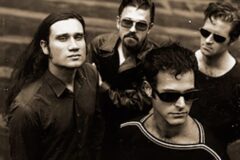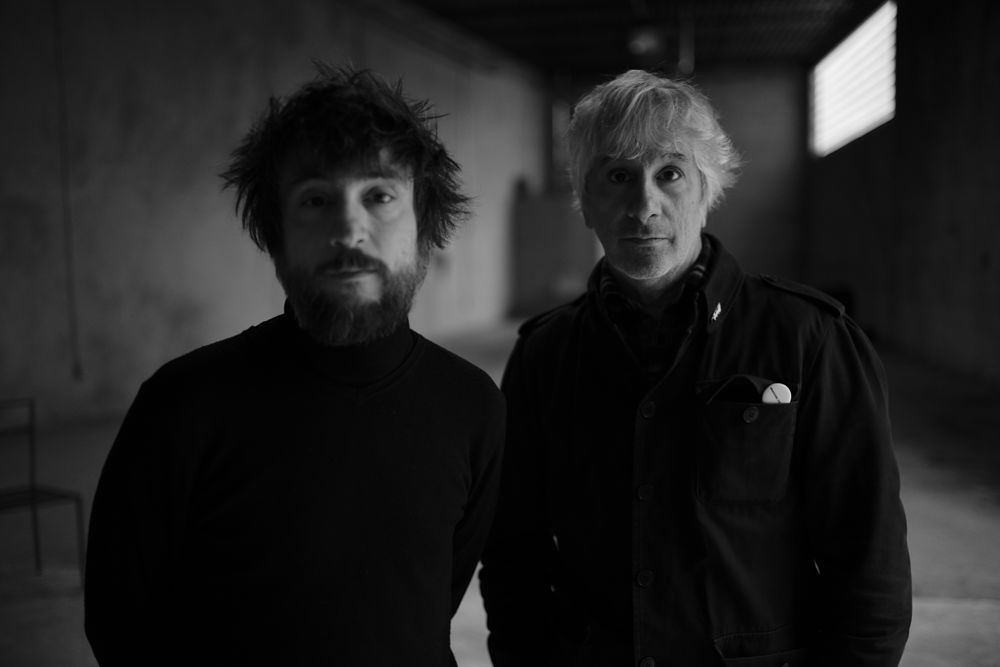Lee Ranaldo, 64, is an elder statesman of American indie rock and experimental guitar, best known as a founding member of Sonic Youth. Raul Refree, 43, is an award-winning Spanish musician and producer, known for fusing rock, jazz, and flamenco on solo albums, film scores, and productions for artists including Rosalia and Silvia Perez Cruz. The two became fast friends after Refree produced Ranaldo’s Acoustic Dust in 2014 and Electric Trim in 2017. Their international and intergenerational collaboration has flowered into their first album as a duo, Names of North End Women, released by Mute last week.
Ranaldo and Refree celebrated the release of the album with an event at NeueHouse in Manhattan on Friday for its new Off The Record Series, and are rehearsing for a European tour in April. While the pair were together in New York last week, they got on the phone with SPIN to discuss the album, which features lyrical contributions from novelist Jonathan Lethem. Ranaldo also spoke about Sonic Youth’s ongoing campaign of archival releases, including this month’s release of the Live in Moscow (April 1989) concert album, and plans for a deluxe reissue of their 1987 classic Sister.
SPIN: Did you start work on this album knowing it would be a collaborative duo project, or did it start out with Lee as a solo artist and Raul as a producer as on Electric Trim?
Raul Refree: I came to New York in July 2018 to work in the beginning of this new album, he had some ideas that we wanted to start working on. But I was coming from Barcelona where I had just done Sonar Barcelona, a concert special for that festival, and I had worked with a lot of samples and making music with electronic textures. So I started to put some of the riffs that we recorded on the sampler and start tweaking them a little bit. And we both thought that it was a very nice beginning for something that was more like a collaboration.
Lee Ranaldo: Yeah, I mean in a way Electric Trim could’ve been listed with both of our names, too, in terms of the depth of the collaboration, you might say. But we were still approaching it with this eye towards an artist-producer relationship. But as soon as we started this one, we realized it should be collaborative all the way down.

Also Read
30 Overlooked 1994 Albums Turning 30
SPIN: Were things written on guitar and then you’d delete the guitar from the track, or would you write on samplers?
LR: A bit of both. The first tracks we generated started from guitar riffs that came out of some demos that I had been working on and were quickly transformed. We were working a lot with the samplers but we were also recording a lot of live stuff, acoustic sounds but not necessarily acoustic guitars, marimbas and vibes, and these Japanese gamelans that Sonic Youth had brought back from Jakarta [Indonesia] in the ‘90s. We didn’t set out to not make a guitar record, it was just that we only gave the guitar the same weight as all the other instruments we were working with.
SPIN: This reminds me of your earlier solo work with tape loops and lock grooves. Were you returning to that side of things or had you worked with those kinds of tools consistently over the years?
LR: Well, in one way or another I guess I’ve been working with that stuff, it just hasn’t been at the forefront. This old-fashioned cassette recorder we use, which was integral to some of the songs, was something I’d been using 25 years ago or something like that. It mostly sat in a drawer recently until we pulled it out. We liked this idea of combining these old analog hissy tape sounds with these sparkly digital sounds and it just seemed to work.
RR: I think that there’s something that represents this record. It’s that we were not feeling that we had to take a certain direction, we were approaching every song like a unique thing. We didn’t know it would become a record, we just wanted to have a good time at the studio, try things, and we were inspired by different elements.
LR: Certain elements that we touched on in the last record, we knew we wanted to do more with spoken word on this record. We were just kind of freeing ourselves from the genre of rock, and indeed most of the things we were talking about, especially as we started, were non-rock influences. Whether it was Ryuichi Sakamoto or Meredith Monk or Max Richter, lots of things that were outside of the realm of two guitars, bass and drums music. And I was thinking about how we were liking these Kate Tempest songs, and she’s kind of a spoken word poet/rapper I guess, but we were just taking inspirations from all these different places.
SPIN: Would Jonathan Lethem just send you words and you’d put them in as you see fit?
LR: Yeah, to a degree. On [Electric Trim] we worked in a little bit more a coherent manner where I was sending him the demos or I would send him a sheet of lyrics and say I need five lines more for this lyric, or I’d send him a sheet with three lines and say I need the other 30 lines or whatever. And we would send stuff back and forth, I’d red pencil it and send it back to him, and he would do the same and send it back to me, and we built it up like that. But with this record, we talked at the beginning of the process. I had this idea based on the title song [“Names of North End Women”], this experience of walking through my wife’s hometown of Winnipeg, in Manitoba, Canada, and seeing these streets where all the signs were the names of women. This was in the north end of Winnipeg, and they were just first names. So early on, I said to Jonathan that I just wanted to work with this idea of including a lot of names in the songs as placemarkers, whether they were actually people from our lives or not. So he ran with that and helped kind of finish it.
SPIN: You and Raul met when you were touring in Spain?
LR: Yeah, I was in Spain with my band The Dust in like 2013. A crazy festival gig in Morocco fell through. And our Spanish promoters, we had just started doing some acoustic shows at that point, and they said: “Well, you’ve got a week free, let’s go into the studio and make a quick acoustic record.” And they brought Raul in to produce, and we just totally hit it off, and by the last day of that session, I was doing vocals in his studio in his home, and as I was leaving, he just said “I’d love to work on a new record with you,” and that was the start of the process that led to Electric Trim.
SPIN: Lee, I wanted to ask you about Sonic Youth’s Live In Moscow (April 1989) album that came out this month. How do things work with archival projects now that the band’s no longer active, are you involved in picking things out for release or is there someone tending to all of that?
LR: We have a couple of engineers and archivist people that we work with. But we’re still all interested in it, we’ve been maintaining a massive archive that continues to grow. Steve Shelley has been really active in it, and the rest of us a little bit less so, but I’ve been pretty active in helping put together the last bunch of packages that come out. In this case, this guy from Russia just said: “Hey, I’ve got this tape of the show” that we had never heard before, and he wanted to put it out. We kind of batted the idea back and forth of whether we wanted to go that route, and in the end, we gave him our blessings to do it. We’re working on an archival project around Sister right now, which is a massive thing we’ve been working on for a while. And two or three other things as well, something around NYC Ghosts & Flowers, and something around a particular concert we did at the Pompidou Center in Paris with Brigitte Fontaine and Areski [Belkacem] that we’ve been trying to cut the legal tape on and release for like a decade.
SPIN: So would these primarily be live recordings or would those projects involve studio outtakes as well?
LR: A bit of both. The Sister package has an 80-minute CD worth of demos and rehearsals and things like that, and the stuff with Brigitte involves a record full of studio tracks plus a live performance. This stuff is stuff that we wanna see come out, but it’s not slated or approved yet. Live tracks for sure, we’ve got tons of live tapes. Often times we would make records before we went out and tested material live, and material would transform in radical ways live. For instance, NYC Ghosts & Flowers, we’re working on a track-by-track live rendition of that record that has a totally different vibe than the way those songs turned out on the record.




